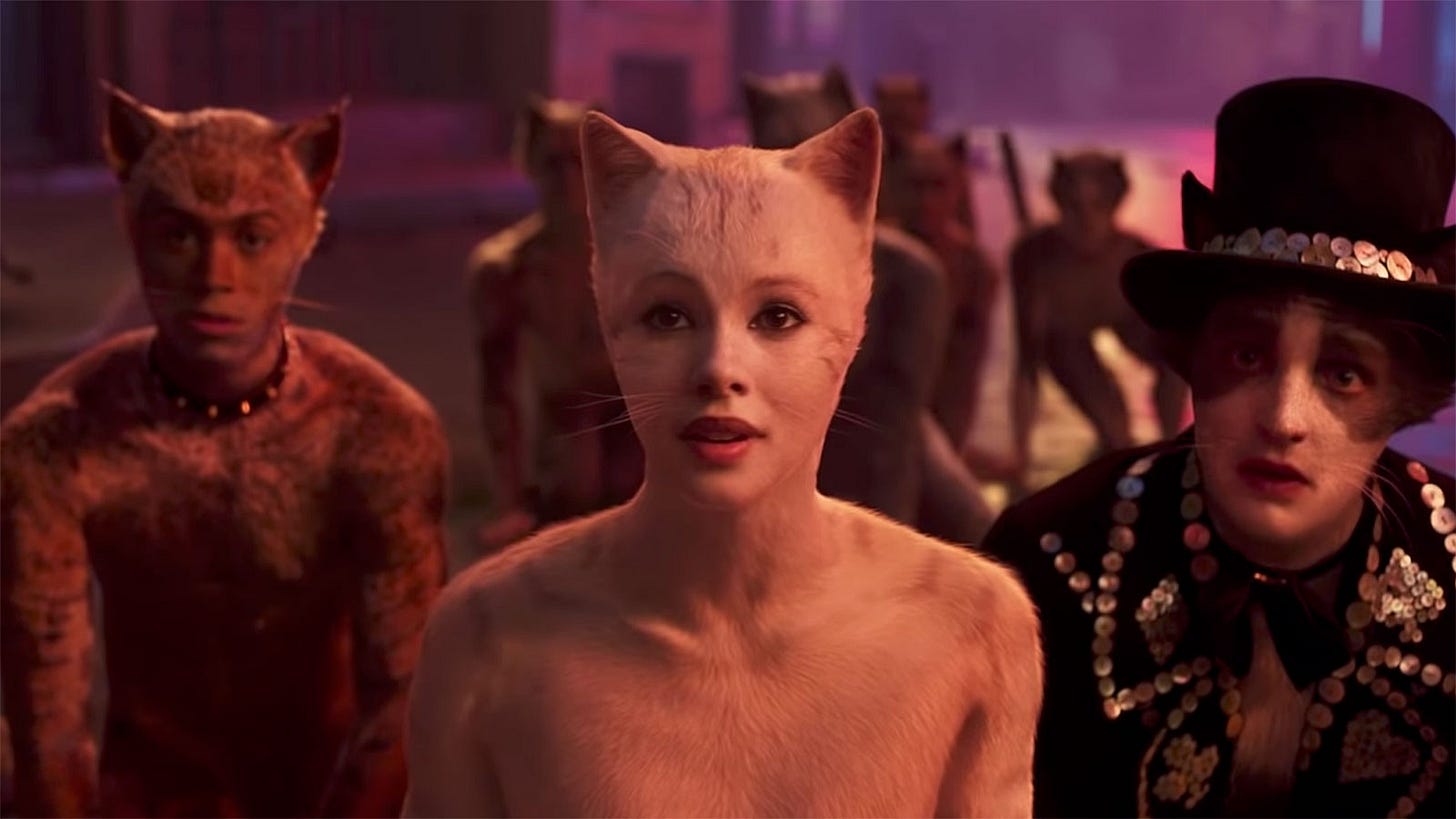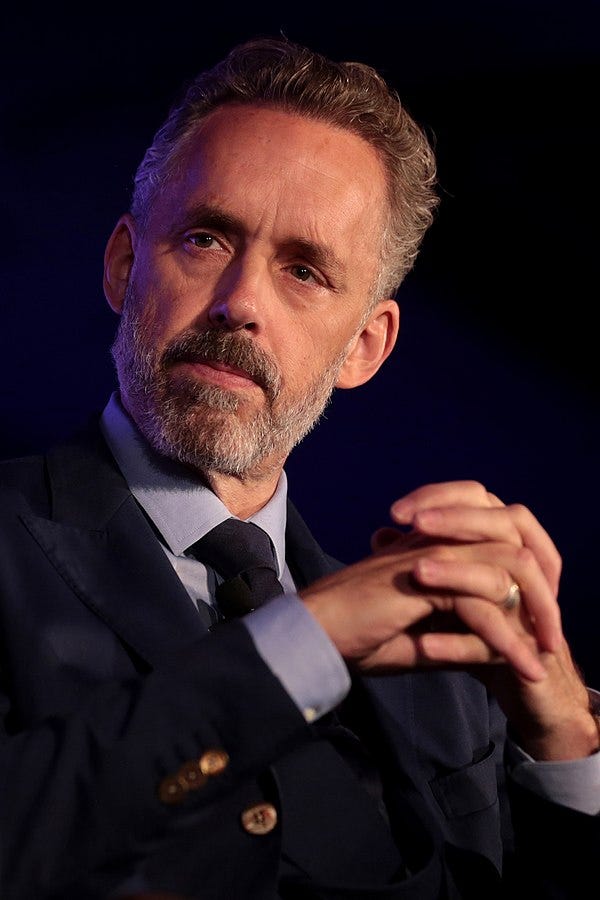The intellectual history of western civilization can be interpreted as a series of texts. So what do we do when a work of art comes along that destabilizes not only our understanding of the world, but forecloses our ability to interpret the world through a textual lens at all?
In the first few minutes of the film, the viewer is thrown abruptly into a fever-dream world. It slaps you in the face with its uncompromising refusal of any sort of exposition. “What the fuck is a ‘Jellico cat?’,” you ask yourself, feeling the irritation tightening in your chest. You feel the impulse to hold onto this refusal for dear life, feeling it to be a life raft of sanity in a reddish-purple hued sea of CGI idiocy. Battered by the incessant singing and dancing, the grip loosens, until, tragically or heroically — or both — you finally let go.
Discussing the film with a friend the next day, he brought up a key plot point of the film. A wave of disorientation washed over me as I realized that I had no idea what he was talking about. Had I failed to keep track of the plot, of the script, as a sort of written memorial to what these bizarre digital creatures had been up to while cavorting around, or had I succeeded in viewing the film as the radically anti-textual manifesto that it is?
Indeed, “anti-textual” is far too limited a frame, because Cats not only resists, but aggressively attacks any attempt at a stable epistemology whatsoever.
The Film Jordan Peterson Tried to Warn us About
“I fucking told you this would happen” -JBP
Cats was absolutely curated by postmodern cultural Marxists. It's deeply destabilizing to conservative cultural sensibilities — or even the concept of having any cultural sensibilities at all — in a way that can only be described as brilliantly courageous. The last time such a brilliantly strident broadside against "Art" as such was launched, was probably Marcel DuChamp's urinal art. It's an unflinching portrait not only of a culture, but even a system of understanding in terminal decline.
Such ontologically destabilizing decadence hasn't been seen since Ovid's Metamorphoses. Parallels to Ovid’s outrageous subversivism are almost too glaring to even bother pointing out — a key aspect of Ovid’s work that got it banned by consecutive Roman emperors was, indeed, its repeated and willful profanation of the human form.
On the surface, Cats is about the epistemological destabilization of the digital age, but it goes much, much deeper than that. This is why the mind recoils when watching it, and the almost compulsive need to immediately dismiss the film as trash. This is nothing more than knee-jerk panic masquerading as highbrow elitism.
But if we resist the fight-or-flight impulse, what kind of space is opened up within the experience of watching the entire film?
The purely visual aspects of Cats give our discomfort an unsettlingly physical dimension. Watching the film, the viewer is immersed in a world where even the cold comfort offered by the rigidity of Newtonian mechanics has been forestalled. As they cavort and undulate, what size are the cats, exactly? Where are they located in space? Where, exactly, is the source of the lighting in this scene? Digital effects have truly come into their own as an art form; from the classical verisimilitude of the Transformers series, we’ve moved on to a visual deconstruction of the medium itself. The film does for CGI what cubism did for painting in the 1930s. One gets the impression that we’ve entered a spatio-temporal realm that has been profoundly disturbed by the sheer power of the titular cats’ polymorphous sexuality. Yes: on watching the film, the viewer is simply compelled to want to fuck the cats.
When watching the film, any comprehensive worldview or epistemic mooring is rendered not only impossible, but it becomes a grotesque joke. If one were a religious person, it would certainly make you doubt the existence not only of "God," but even of the category of "sacred" as such.
Compared to the existential horror of 2019’s Cats, even Hereditary — made a mere two years previously — is rendered completely ineffectual. The horrific psychodramas of an Ari Aster, or even the gothic visions of an HP Lovecraft, look like the notepad doodlings of a boy scout by comparison. Why? Both forms of cosmic horror rely on some referent of normalcy from which to gather their disturbing power. In traditional horror, we're awed by the presence of the sacred in a negative sense - the existence of pure evil.
Cats opens our eyes to a far more disturbing possibility than that of our own obliteration at the hands of a malevolent force: the prospect that the distinction between sacred and profane itself may be rendered absurd by a single act of willful iconoclasm. Cats isn't merely profound supernatural horror - the categories of natural and supernatural, disgust and beauty have been so destabilized that we've lost the necessary grounding to even feel horrified at all.
This creates a rupture in the fabric of our collectively imagined reality that no amount of effort can mend. It is, in a word, an act of artistic terror. We have here what Baudrillard, in his oft-misunderstood masterwork, The Spirit of Terrorism, called “the event.” The terrorist “event,” for Baudrillard, is impervious to intellectual processing: “Defy the system by a gift to which it cannot respond except by its own death and its own collapse.” Cats, I’m convinced, is such a gift, using the medium of film rather than political violence. The negative reviews were a far too hasty reaction to this masterwork: “The whole play of history and power is disrupted by this event, but so, too, are the conditions of analysis. You have to take your time.” Time to step back and reflect is one thing that film critics, working under the rigors of digital capitalism, simply don’t have.
This kind of epistemic destabilization, though, does not preclude some pretty incisive social commentary. It’s the film of our time, harkening back to the domestic certainties of mid-century Fordism (the housecat being a totem of domesticity, even in Ancient Egyptian days) while at the same time foreshadowing the profound ontological unmooring of Covid lockdowns (the film having been made in the same year that the Covid virus emerged in Wuhan). The perverse juxtaposition that this generates is as unsettling as the pandemic era itself.
Watch Cats, and fully inhabit, if only for two hours, the desert of our shared reality. If you dare.


